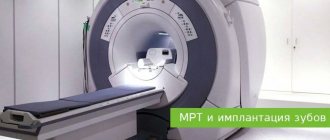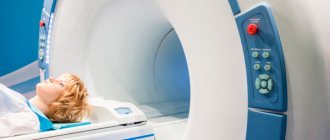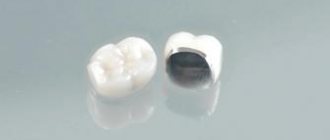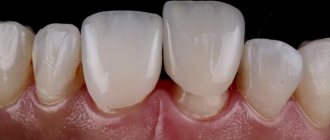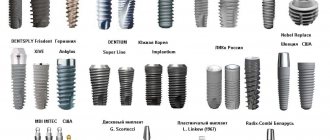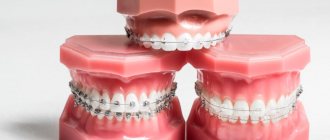Nowadays, implantology is already quite common, and you probably know more than one person who has dental implants installed.
Sometimes, if they are present, the patient may face difficulties. For example, everyone knows that one cannot undergo magnetic resonance imaging if there is metal in the body. Does this apply to dental implants?
It is not without reason that patients are wary of undergoing this procedure if implants are installed.
But let’s reveal a secret in advance - dental implants are not a contraindication to MRI.
During the examination, the implants do not move anywhere, much less pull out of the jaw. An MRI of a dental implant will not detect anything, so this is rather a myth, which we will dispel in this article.
The fact is that modern implantological systems are based on implants made of titanium and its alloys, which are not magnetized and, accordingly, do not interact in any way with the magnetic field that is created by the MRI machine. Even older implant systems that are slightly exposed to magnetic fields do not become magnetized enough to cause harm.
It should also be taken into account that dental implants are very well fixed in the bone tissue, which additionally provides some guarantee that they will not move during an MRI.
When you can and cannot do an MRI of the brain with dental implants and metal crowns
Article navigation
- How does MRI work?
- When and who should not undergo the study
- MRI in the presence of an implant
- Do metal dental implants move?
- MRI of the head, brain and neck with implants
- Risks of MRI diagnostics with titanium dentures
- Should I tell my doctor about implants?
- Admission to tomography in the presence of crowns
- MRI of the brain in the presence of braces
- Myths for patients with implants
question to a specialist
In the age of modern technology, only the lazy have not heard of such a wonderful diagnostic device called a tomograph. There are several types, but the most accurate is the magnetic resonance machine. Doctors of various specialties refer for MRI. But a number of patients have a question: is it possible to do an MRI with implants and metal crowns on teeth? The answer to this question will surprise many - read further in our article about diagnostic methods for people with metal dentures and contraindications.
Indications and restrictions
Before determining whether an MRI can be done with dental implants, it is necessary to understand for what diseases this procedure is prescribed. This technique can be indicated for a wide range of pathologies.
Due to the absence of X-ray radiation, the method is suitable for diagnostics during pregnancy and childhood.
The procedure is recommended for the following pathologies:
- problems with blood circulation;
- presence of blood clots;
- internal bleeding;
- vascular aneurysms;
- heart pathologies;
- diseases of the musculoskeletal system;
- various inflammations;
- diseases of internal organs.
MRI has very few absolute contraindications. This list includes the following factors:
- the presence in the body of materials capable of magnetization (steel, nickel, iron, cobalt, chromium, etc.);
- the patient has clips that stop blood in the vessels;
- wearing a pacemaker;
- tattoos made with a certain type of dye.
Quite often, dentists prescribe a CT scan to determine the condition of the dental system. Many people who use metal dentures undergo this examination. It should not be confused with MRI.
In order to get a good result, you need to tell your doctor in advance about the presence of such elements in the oral cavity and tell them what material they are made of.
The procedure may be prescribed in the following cases:
- The occurrence of discomfort when eating.
- Crunching when moving the jaw.
- Pain in the lower jaw area.
- Spasms that occur when the patient opens and closes his mouth.
MRI images look something like this
How does MRI work?
Let's figure out what a magnetic resonance imaging scanner is and how it works. This device is designed for targeted examination of tissues and blood vessels of the body. Modern devices with a power of 1.5-3 Tesla are capable of identifying problem areas smaller than 0.2 mm. The principle of operation is based on radio waves and the magnetization properties of the nuclei of hydrogen atoms, which are located everywhere in the body (and we remember that a person is 70% water).
The nuclei of hydrogen atoms “respond” to a powerful magnet (enter into resonance), and a special program records a picture and displays it on a computer. The diagnostic result consists of many virtual sections or sections of the desired organ - the brain or spinal cord, liver, vascular system, etc. And the radiologist makes a written report on the data obtained.
%akc54%
In general, there are two types of tomographs that are installed in specialized institutions - a cone-beam tomograph (CT) and an MRI machine itself. The first, even with implants, does not distort the image, but is also not suitable for studying small areas (for example, brain tumors). During an MRI, a magnet may cause some image distortion in the area of metal products in the body - but whether implants are included in this list will be discussed later.
On a note! Tomographs are also available in dentistry - they are less powerful and give a much worse picture (however, for the needs of the clinic this is enough). Neither the presence of implants nor the presence of metal crowns is a contraindication to this study. However, such devices are cone-beam and do not contain magnets.
Is it possible to do an MRI if you have dental implants?
Many patients: “Can I do MRI with dental implants?” After all, today every third person has pins installed.
Indications for use
The reason for prescribing this procedure may be a suspicion of a tumor, disruption of vascular activity or blood supply to tissues. Most often, MRI is prescribed as the main examination of the brain, spine or spinal cord to diagnose diseases of the osteoarticular system and abdominal organs. The doctor can prescribe diagnostics for ligament injuries, gynecological diseases, kidney diseases, suspected tumors and metastases.
Features of the procedure
This procedure can be carried out both for the patient’s entire body and for a separate part. The patient lies down on the couch with the head fixed. The couch is then moved inside the MRI machine. The procedure takes from 30 to 90 minutes. The patient spends this time in a relaxed and motionless state. A special feature of the procedure is the loud noise of the device, so the patient is provided with either headphones or earplugs. Throughout the procedure, the patient has access to an emergency interrupt button. Before the procedure, all metal objects must be removed. In some cases, the procedure is performed under anesthesia. The images are usually ready immediately after the examination or the next day.
When and who should not undergo the study
In response to the question: “Is it possible to perform MRI with dental implants?”, doctors answer in the affirmative. But a number of conditions must be observed - they do not relate to the implants themselves, but are of a general nature. First, let's systematize the contraindications to this study. They are divided into 2 groups – relative and absolute. The following are considered absolute contraindications:
- any large ferromagnets in the human body: large metal implants on bones, middle ear prostheses, metal fragments in soft tissues. But dental implants are not included here,
- electronic stimulators: on the heart, middle ear prosthesis.
Ferromagnets are substances and alloys containing nickel, chromium, steel, cobalt, and any compounds with a large percentage of iron. Highly susceptible to magnetism. In a powerful magnetic field, ferromagnets can move if they are located in soft tissues. The consequences of such a movement are almost always unpredictable and can cause harm.
Relative contraindications - this term hides restrictions on MRI that can be circumvented. For example, undergo diagnostics later or on a different device. Let's consider the relative contraindications to MRI:
- inability to lie still during the examination: this may include small children and patients with nervous disorders. They are put into a short medicated sleep,
- early pregnancy: due to the lack of confirmed data on the harmful effects of the magnetic field on the fetus,
- hemostatic clamps in blood vessels,
- tattoos: if metal is present among the components of the pigment, then it will heat up in the device, even causing burns,
- braces, crowns or other prosthetic devices that contain ferromagnetic metals - primarily steel. But there are some peculiarities - if the prosthesis is in the mouth, and you do an MRI of the leg, then there are no risks.
Contraindications mainly relate specifically to MRI, and the closed type - when the patient is completely placed in the machine. There are also open-type tomographs - they have fewer restrictions for diagnosis, but their accuracy is lower.
What is MRI and how is tomography performed?
Tomography is the most universal method of examining the body. The effectiveness of MRI is based on the use of a unique physical phenomenon called nuclear magnetic resonance. During diagnostics, hydrogen atoms located in the human body begin to emit subtle radio signals. They are tracked and organized by a tomograph - a device responsible for a constant magnetic field. The computer then reads the information and displays it as a three-dimensional image.
During the procedure, no X-ray radiation is generated, so MRI can be done for people with some contraindications for the first factor. Tomography is an absolutely safe method, however, in the presence of implants, the procedure is prescribed individually.
Today, MRI shows the highest results in diagnosing brain diseases. This technique is prescribed for bruises, concussions, suspected tumors, aneurysms and other disorders. The examination session lasts 10-30 minutes, the patient does not experience any pain during the procedure. Tomography is accompanied only by noise and clicks characteristic of the device. The sounds are quite loud, so doctors provide special headphones or comfortable earplugs. Sometimes people fall asleep during an MRI.
The diagnostic device is placed in a room with a small window through which the doctor observes the examination process. While the device is working, no one else is present in the room, but the patient can contact the specialist via speakerphone. The only thing that is required of a person is to maintain a stationary horizontal position; movements can affect the overall picture of the pictures.
Magnetic resonance imaging in the presence of a dental implant
So why wouldn't a dental implant be an absolute limitation to MRI? Here you need to understand that implants are made from metals endowed with diamagnetic and paramagnetic properties. What it is? The operation of an MRI scanner is based on the magnetizing properties of certain substances. So, para- and diamagnets react weakly to powerful magnets, such as those installed in the tomograph.
Paramagnetic materials are almost not subject to the action of a magnetic field and do not shift in it. These are the following materials:
- titanium: the main metal from which modern implants are made,
- aluminum: medical gurneys made of this metal can be brought into the room where MRI is performed,
- platinum: softer and more expensive than titanium.
Diamagnets - magnetization is not significant, it occurs in the direction of the applied field:
- hydrogen: it was the presence of this element in the human body that made magnetic resonance imaging possible,
- copper: oxidizes quickly, not suitable for implantation into the body,
- gold and silver: very soft metals.
Magnetic resonance imaging can be performed on any part of the body. If the organ being studied is located in the lower half of the body, then the implant will not affect the result in any way. And if the upper part is examined, then there may be some distortions - however, the implant itself will not move, that is, it will not be magnetized and will not break out of the body.
How does magnetic tomography work?
Today, MRI is considered the only method of radiation diagnostics, which provides the most accurate information about the condition of the oral cavity. Tissues and organs are visible in different projections, so the dentist is able to draw accurate conclusions from the images obtained. Such high-tech devices operate on the basis of the interaction of radio waves and a magnetic field. If you have dental implants, diagnosis is not prohibited. The operation of the device is based on nuclear magnetic resonance. Using NMR, a layer-by-layer image of the examined object is obtained.
Clarification! NMR refers to physical phenomena with special properties of atomic nuclei. The radio frequency nature of the pulses radiates energy in an electromagnetic field, which is expressed as a signal. This energy is displayed and stored on the computer.
Nuclear magnetic resonance makes it possible to obtain information about the patient’s oral cavity due to the saturation of hydrogen atoms and the magnetic properties of organic tissues. When a particular zone is affected by electromagnetic radiation with a certain frequency, some of the protons change direction. At this stage, with the help of a computer system, information materials obtained through a tomograph are collected. More detailed information is located on one of the pages of our website. Follow the link Installing a dental implant and get acquainted with detailed information.
Do metal dental implants move during examination?
To understand whether an implant can move under the influence of a magnet, you need to know what it consists of. Dental implants are a modern replacement for your own lost teeth. It consists of a metal implant (reliably fixed in the jaw bone and replaces the tooth root), an abutment (connecting part) and a crown - an analogue of the upper part of the tooth. If the prosthesis is installed efficiently, then it is not at all perceived as a foreign body. It looks like it's your own tooth. These sensations are achieved thanks to the special structure of the implant - it contains micropores, and bone grows into them over time. Thus, it fully replaces the tooth root and does not wobble.
Why the implant does not move during MRI:
- rigid fixation in the jaw: the bone securely holds the tooth root prosthesis in place,
- consists of titanium: i.e. does not magnetize and does not heat up.
CT scan of the jaw and dental implantation
Computed tomography is considered one of the most informative diagnostic methods. With its help, three-dimensional images are obtained that show the dental system as it exists. In many cases, CT is the only possible diagnostic method for making a correct diagnosis, and the use of alternative methods is not possible. Therefore, many contraindications that are not absolute are ignored and the procedure is carried out.
The presence of pins and metal dentures is not an absolute contraindication, so the answer to the question – is it possible to do a CT scan with dental implants – will be positive. But before the examination, it is necessary to warn the radiologist about the presence of metal dentures, crowns or pins.
Content
- CT as an effective alternative to MRI for diagnosis
- Why is a CT scan performed with dental implants?
- The importance of jaw CT for implantation
- The value of a CT image for dental implantation
- Is it possible to do a CT scan with metal implants?
- Computed tomography of teeth in St. Petersburg
CT as an effective alternative to MRI for diagnosis
Magnetic resonance imaging is also widely used to diagnose and identify diseases such as pulpitis, arthrosis and arthritis. But its implementation, as a rule, is prohibited if the patient has metal crowns and implants.
This is explained by the fact that under the influence of a magnetic field, most metals that are used to make orthopedic structures can significantly distort the image, so the value of MRI as a diagnostic method will be completely lost. Moreover, metal elements can heat up and shift under the influence of a magnetic field, which already poses a danger to the patient’s health.
CT is based on the use of x-rays, so tomography with metal crowns is not contraindicated. Moreover, this method is used to assess the quality of the implantation performed, as well as to identify complications that are invisible during visual examination.
Why is a CT scan performed with dental implants?
CT in the presence of implants is used in the following cases:
- Establishing the fact of implant engraftment and the timeliness of this procedure.
- Identify the cause of instability and shakyness of the installed structure.
- Assessment of the overall quality of the implantation performed. This is especially true if the procedure was carried out without prior 3D modeling and planning.
From all this we can conclude that computed tomography is used to evaluate procedures and identify possible complications and errors in prosthetics. CT is also performed as a preparatory procedure before the upcoming dental implantation.
The importance of jaw CT for implantation
Computed tomography of the jaw for dental implantation is the most accurate research method. Thanks to him, the result will be exactly the same as planned. This is explained by the fact that CT provides a three-dimensional image of the area under study, in contrast to the same orthopantomogram, which produces images in one plane.
The examination recording can be viewed on any PC. At the end of the tomography, the results are recorded on a CD with universal software, which is automatically installed on the attending physician’s computer.
With CT you can:
- See fabrics layer by layer. In the resulting image, you can see pathological processes in bone tissue, as well as assess bone density. All this is very important when planning dental prosthetics.
- Measure distances and angles. A high-definition and detailed image allows you to select the exact dimensions of the implant (using the program you can measure the width and height of the alveolar ridge).
- Consider the structure of tissues in several projections.
- Determine the location of blood vessels and nerves, as well as the location of the maxillary sinuses.
- In modern tomographs, it is possible to transfer the obtained data into a program for three-dimensional modeling.
A tomograph takes a series of pictures before dental implantation. The result is a digital 3D image in which you can examine the maxillofacial area in great detail. Bundles of nerves and blood vessels, dental roots and canals, soft tissues, maxillary sinuses, etc. are clearly visible.
CT, as a diagnostic method, is extremely important for dental implantation. Without it, proper planning of the operation is impossible. If a smaller implant is installed, the load on the tissue will be excessive, causing the area around the implant to become very inflamed (peri-implantitis). An error with the placement of an artificial tooth will lead to malocclusion and other negative consequences.
CT is a computer technology, so the human factor is eliminated and, as a result, the likelihood of error is significantly reduced.
The value of a CT image for dental implantation
The slightest miscalculations when restoring lost teeth can lead to serious consequences. If a specialist does not have a detailed photograph of the jaw, then this is very bad for proper implantation.
Incorrect installation of the implant will lead to the following consequences:
- Uneven distribution of load on bone tissue will lead to increased sensitivity of the gums. If there is no load at all, this will lead to atrophy.
- Nerve damage.
- The service life of the orthopedic structure is significantly reduced.
- The need to install a new implant, and this is an additional financial expense.
Based on this, we can say that a computed tomography scan is a necessary preparatory procedure before the upcoming installation of artificial teeth. The implantologist will have a detailed 3D image, which will allow him to carry out prosthetics in exact accordance with the specific clinical picture.
Is it possible to do a CT scan with metal implants?
When determining the advisability of performing a CT scan on patients with dental implants, crowns and posts, the metal from which they are made plays an important role. In any case, there will be no harm to the body, but there is a possibility that optical distortions will appear in the image, which will reduce the information content of this diagnostic method.
Orthopedic structures can be made of medical metal, which does not affect the results obtained at all. If ordinary metal is used in the manufacture of implants or crowns, then there is a possibility of unwanted optical effects appearing in the images. All this can affect the correctness of the diagnosis, so before the procedure you must inform the specialist about the presence of metal orthopedic structures in the oral cavity.
The presence of a pin in the oral cavity is a separate case. If it is made of ceramics, then computed tomography is performed without any restrictions. If it is made of ordinary metal, then the choice of examination method is made based on:
- Specialist qualifications.
- Technical equipment of the clinic.
- Possibility of using alternative diagnostic methods.
The qualifications of the diagnostician and the radiologist who will interpret the information received are of great importance. A qualified specialist with many years of experience will correctly interpret the results of a tomogram that contains metal or titanium pins.
Computed tomography of teeth in St. Petersburg
Today we looked at whether it is possible to do tomography with dental implants. The presence of orthopedic structures in the oral cavity is not a contraindication to the study, so it is carried out if the situation requires it. There may be slight optical distortions in the images, but an experienced doctor can easily interpret the information received correctly.
X-ray - have been operating since 2015, conducting high-precision X-ray examinations. Examinations are carried out using the latest tomographs, which allows obtaining detailed images with great diagnostic value.
Our specialists have sufficient experience and qualifications. The examination is carried out without negative consequences for your body. The results of the study can be recorded on digital media for further provision to medical institutions.
Sign up for a study by phone
+7 (812) 332-52-54
MRI of the head, brain and neck for patients with dental implants – can it be done or not?
The brain is the control center for all organs of the body, and its proper functioning is vital. And nature could not leave such a necessary organ without protection, i.e. skulls But it is precisely this that creates a serious obstacle in the study of diseases of the brain and its blood vessels. X-rays and ultrasound cannot “enlighten” the skull, and computed tomography is low-power and will not be able to show pathological areas smaller than 1 mm in size. For this reason, MRI is prescribed to study the soft tissues of the head - the brain and blood vessels - as the most informative method.
MRI of the head with titanium dental implants has no contraindications and can be done. Just first you need to check with your dentist what material the implant is made of (although you should also have this information on hand), but the prosthesis. If you have metal-ceramic crowns installed, they may contain steel impurities - then it is better to refuse magnetic resonance imaging and undergo PET (positron emission tomography) or CT (computed tomography).
On a note! If one center refuses to give you an MRI, go to another - modern devices can muffle the “noise” from metal implants. But, naturally, these are the latest generation devices and you need to look for them.
Before undergoing an MRI, you must indicate in the questionnaire that you have a dental implant. Tell the specialist about this immediately before diagnosis.
How long does a crown stay on a tooth?
The service life of entire crowns primarily depends on the material. So:
- metal ones last an average of 5 years;
- metal-ceramic – 8-10 years;
- ceramic and zirconium dioxide - 10-15 years and above.
The duration of wearing dentures is also affected by: how well the supporting tooth was treated and ground, the skill of the dental technician and the quality of oral care. The dentist is visited every six months to remove plaque from products and adjust them. And after 7-10 years, most crowns become unusable and are replaced with new ones.
But loose and broken dentures will not last long: from several days to a couple of weeks. Therefore, people contact the clinic immediately: the faster the doctor adjusts or replaces the bridge or crown, the greater the chance of saving the abutment tooth.
This is how a crown is sawed
Risks of MRI diagnostics with titanium dentures
Due to the fact that prostheses implanted into the jaw bone are mostly made of paramagnetic titanium, magnetic resonance imaging with dental implants is a completely feasible and completely safe procedure. Titanium is a biologically inert material, i.e. it is not able to oxidize and release harmful substances during contact with bones, muscles and blood vessels of the human body. Of course, in medicine it is not pure titanium that is used, but its alloys with a small amount of other elements. This is done to make the material durable and light. But they also do not have any negative impact when undergoing an MRI.
By the way, titanium is comparable in strength to steel, and in lightness - to aluminum. Therefore, this metal has received recognition not only from dentists, but also from traumatologists and orthopedic surgeons.
Titanium is also used to produce abutments, gum formers, and metal arches (bases) for dentures.
Important nuances
There are a large number of different implants and orthopedic structures. When using certain products, the patient often has concerns about the effect of such items on MRI results. In order to finally clarify the situation, you should familiarize yourself with the following characteristics:
- Metal crowns and dentures. The pins are most often made of titanium, and the products themselves are made of metal ceramics. Although the design contains metal, its amount is minimal, so it is not able to heat up during the procedure. But if the crown was made entirely of ferromagnetic material, the doctor may suggest an alternative examination method - computed tomography (CT).
- Types of braces. Iron braces can greatly affect the results of an MRI of the jaw or brain. There will be spots on the image. This happens due to the size of the products. During the procedure, braces cannot spark or heat up, much less deform, but the examination may be inconclusive. It is worth remembering that not all products consist of metal inserts; there are ceramic and plastic models.
MRI is a very effective and convenient examination method. Diagnosis can be carried out even with dentures, but there are some nuances. Ferromagnets and solid metal brackets can indeed significantly affect the results of studies. In this case, you should consult your doctor. If there are contraindications for MRI, the specialist will definitely suggest an alternative method of examination.
Should you tell your doctor that you have dental implants?
A patient with installed dental implants must notify the doctor about this. Then the specialist makes the necessary adjustments, taking into account the location and composition of the prostheses. These settings eliminate the appearance of blurred distortions (also called field artifacts). And then the results of the examination will be clear and precise.
But if a person decides to keep silent about “non-native” teeth, then the picture will turn out blurry, because implants, although slightly, do affect the quality of the pictures. And such a careless patient will have to pay for the procedure and undergo diagnostics again. Why does the blame in this case fall on the patient? Because before the MRI, he will definitely be asked about the presence of implants and what kind of metal they are made of.
“Mom 2 years ago had an MRI of the head and blood vessels, using a high-field tomograph. And she’s had implants installed in her upper jaw for about 5 years now. And nothing, everything went fine. There are no special sensations during the procedure. Just be sure to tell the girls at the reception that there are implants before starting the procedure. They warn the doctor themselves, and then the device is reconfigured.”
Vitalina, from correspondence on the woman.ru forum.
How is it carried out?
The procedure is painless and takes 5 - 10 minutes. Before starting, the patient will be asked to remove metal accessories and hearing aids, which cause false darkening in the image. The safety of internal organs susceptible to radiation (thyroid gland, reproductive system, heart) is ensured by protective pads and vests.
In dentistry, the injection of a contrast agent is rarely used. If such manipulation is indicated, you should come on an empty stomach. Tests are carried out in advance to determine individual sensitivity to the drug.
To perform it, you need to sit or stand, pressing your face tightly against the frame of the device. The X-ray room employee will tell you the correct position. The head is fixed with a special stop to prevent “smearing” of the images. You cannot move while a 3D photograph of your teeth is being taken.
Is it possible to have access to tomography if I have crowns?
Are there any special features in MRI diagnostics for patients with dental crowns? This question also worries many. Some people worry that under the influence of magnets, metal, metal-ceramic crowns and pins can fly out of their places and damage something in the mouth. Experts note that metal crowns and pins have absolutely no effect on MRI results, but only if they are made of pure ceramics, zirconium dioxide or high-quality alloys. If the crown is made of metal-ceramics, then it is worth clarifying the metal content in the base - it is likely that you will not be allowed to conduct research.
Impact of implants on research
Over the past 10 years, patients have most often been fitted with prostheses made from inert materials, such as platinum, zirconium or titanium. Such products are not included in the list of contraindications for MRI. Dental implants made of silver or gold may affect diagnostic results. Before undergoing a tomography, you need to tell the doctor about the presence, area of placement and material of the prosthesis.
Products installed in the oral cavity are so tiny that the electromagnetic field is not able to heat them or move them in any way. Moreover, during the tomography, the patient holds a special device in his hands, by squeezing which you can stop the examination.
Thus, the question of whether it is possible to do MRI with titanium implants has been completely resolved. The presence of such metals does not in any way affect the effectiveness of the procedure. Problems may arise if the pins or crowns were made of iron or other materials subject to magnetization. When examining parts of the body below the chest, the presence of any metal dental implant is not at all important.
In modern prosthetics, professionals recommend installing paramagnetic materials - non-magnetic materials. One of the most common alloys is titanium. This metal has many advantages compared to other substances:
- no toxic emissions;
- maximum survival rate;
- reliability and functionality;
- absence of vanadium in the alloy;
- the presence of an oxide film that protects the implant from the influence of the external environment;
- hypoallergenic.
MRI of the brain in the presence of braces
At the beginning of the article, we talked about relative contraindications to undergoing magnetic resonance imaging. These include various bracket systems. Such structures rarely contain titanium (the structure is still bulky, and titanium is not a cheap metal), so they are made from inexpensive ferromagnetic materials (mostly medical steel). These materials, in turn, are magnetized in an MRI scanner. Therefore, braces, retainers and clasp dentures are prohibited from MRI scanning of the head and neck.
But you can undergo diagnostics of the lower part of the body or in an open-type apparatus.
But if the clasp prosthesis is easy to remove and undergo diagnostics without problems, then difficulties may arise with braces. There are 3 ways here:
- Braces and retainers can be removed: if urgent examination is required,
- undergo PET or computed tomography: there are no contraindications for them,
- undergo an examination after the end of the period of wearing braces or retainers: if the diagnosis is not urgent.
DENTAL PROSTHESIS WITH 4 OSSTEM IMPLANTS - RUB 170,000!
Implantation even with bone tissue atrophy. Work guarantee! Save RUR 20,000.
on promotion >> Free consultation with an implantologist +7 (495) 215-52-31 or write to us
How can MRI affect iron crowns?
Prostheses made of iron, steel, cobalt alloys and other ferromagnetic materials are still most often installed. Yes, there is titanium, porcelain and zirconium dioxide - but they are expensive, so not everyone can afford them.
Iron orthopedic structures are durable and cheap. But they become a problem if you need to do an MRI for 4 reasons:
- They distort the picture. The results will not be accurate. This is especially critical when diagnosing oncological pathologies: MRI is the best method for identifying tumors at the initial stage, when recovery success is high.
- They get very hot. This leads to a burn of the mucous membrane.
- They move from their place. After displacement, the crowns will have to be adjusted, re-attached, or new ones made.
- Possible loss. The magnetic field attracts metal crowns - it literally rips them out of your mouth.
Iron crowns get very hot and distort MRI results
Patients with metal prostheses are recommended to remove the structures before MRI or undergo another study - CT, PET. The above applies to closed-type tomographs or when examining the head, cervical or thoracic region. There is no risk when diagnosing other parts of the body.
Myths for patients with implants
The most common myth about magnetic resonance imaging scares most patients. An incompetent interlocutor - a work colleague or a neighbor next door - may say in horror: “What, you can’t do a tomography with implants - the prosthesis will be pulled out of the jaw by a magnet and it will stick somewhere, or the device will be damaged.” And the person will believe and refuse MRI in favor of a less informative, but more harmful examination (for example, computed tomography).
Every patient referred for magnetic resonance imaging should remember that dental implants are not a contraindication. And if you are denied such an examination, then you need to look for a clinic with modern equipment and a qualified radiologist.
Author: Vasiliev A. A. (Thank you for your help in writing the article and the information provided)
With which implants are MRIs allowed?
Tomographic examination can be performed for people with hip and knee joint replacement. An important rule for passing screening is the material from which the structure is made. It can be metal or ceramic, but their magnetic susceptibility should be minimal. Such material will avoid displacement of the structure or its overheating during diagnostics.
MRI is performed on patients with hernia meshes, dental prostheses, implants built into the chest and joints. All these elements are created from a material that does not in any way affect or interact with magnetic vibrations. All this allows us to make the tomography process safe for humans. It is important to consult with your doctor and diagnostician before scanning. Doctors will assess the likely risks and recommend precautions.
Dental indications for tomography
- Diseases of the temporomandibular joint;
- the presence of extraneous sounds when closing and opening the jaw, displacement of the lower jaw to the side;
- malocclusion;
- involuntary jaw movements;
- pain, discomfort when chewing food;
- spasms of muscle tissue when opening and closing the mouth;
- complications after treatment or tooth extraction;
- diseases of the pulp, gums;
- study of neoplasms in the maxillofacial region.
Contraindications for MRI
MRI cannot be performed if there are metal objects in the body:
- hip or knee endoprostheses made of cobalt-chromium, cobalt-chromium-molybdenum alloys;
- steel plates, pins and screws;
- circular steel devices (Ilizarov, etc.);
- ferromagnetic middle ear implants;
- metallic tattoo dyes;
- metal fragments or bullets that cannot be removed for safety reasons;
- prosthetic heart valves;
- hemostatic clips.
The procedure is also contraindicated
, if observed:
- severe physical condition of the patient;
- installed nerve stimulators or insulin pumps;
- neurological diseases, mental disorders;
- claustrophobia;
- first trimester of pregnancy;
- decompensated heart failure;
- need for hardware monitoring.
How is a dental CT scan performed?
3D dental tomography
Computed tomography of teeth is characterized by ease and simplicity of the procedure and does not require special preparation of the patient. The research apparatus is not too large and has a low radiation dose. The whole process is painless, takes no more than one minute and takes place in three stages:
- The patient removes all metal objects from himself and, in a sitting or standing position, rests his chin on a special stand, which will allow him to fix the jaw in the desired position.
- During the examination, the specialist monitors the patient's immobility and turns on the computed tomograph.
- A three-dimensional image and various data are displayed on the doctor’s screen, which are then stored in the computer of the clinic where the examination is carried out; this is much more convenient than x-rays.
